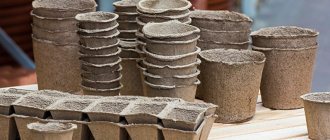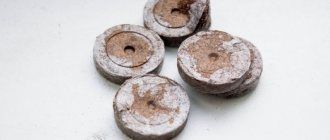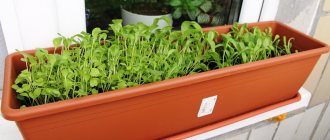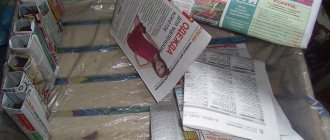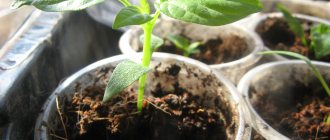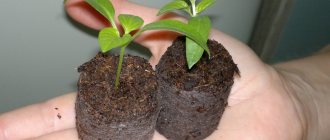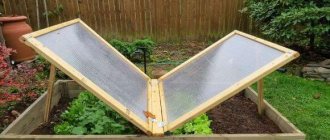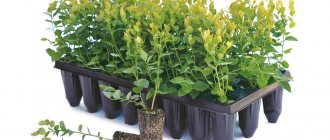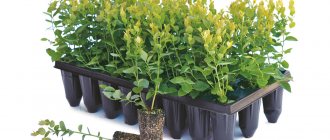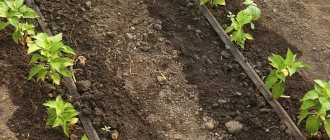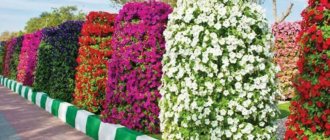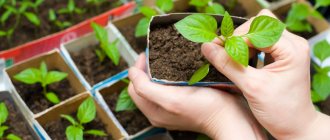Many flower growers and gardeners have seen peat pots for seedlings on sale. Not everyone knows how to use it. The use of small flowerpots made of peat has many positive aspects, but improper use can lead to problems when growing seedlings.
How to choose high-quality peat containers? How to store cups made from natural materials for seedlings? Is it possible to form peat pots with your own hands? What are the pros and cons of conical cups made from natural materials? The answers are in the article.
What are peat pots made of?
Peat pots appeared 50 years ago.
Their basis was pressed peat mixed with cellulose. Today, manufacturers include coconut fiber and even sunflower cake in their composition to improve air circulation. Such containers are much stronger than classic peat-cellulose flowerpots and are protected from the development of fungus. Most brands offer consumers pots consisting of:
- peat;
- humus;
- wood ash;
- oily soil.
Cups made of 50% cardboard are also sold on the market. They do not allow air to pass through well, which is why the roots of the seedlings begin to rot during the process of growing seedlings. You can visually distinguish them from high-quality peat containers by their walls: the cardboard is smoother than pure peat.
Properties
Peat pots are used due to the integrity of the roots; when transplanted to a new place, the plants quickly take root and grow. The soil poured into such containers retains moisture longer. From the moment of sowing until the period of planting in a permanent place, the roots of tomatoes are in the same substrate.
Nothing prevents the . After planting in the ground, the roots quietly grow through the soft walls of the pot. They withstand soil loads well.
How to use peat pots
Peat cups are prepared in advance for sowing seeds. First, the inner and outer surfaces of the flowerpot are treated with a fungicide, and then the pot is completely soaked in a mixture of organic and mineral fertilizers. Next, it is dried and small holes are made in the walls. You can use a stationery hole punch for this.
Pre-preparation will allow the roots of the seedlings to break through the dense walls of the pot.
The soil for growing seedlings in peat pots is loose and only with a neutral pH level, since the walls of the flowerpot initially have high acidity. If the crop being grown requires a low level of acidity, eggshells are placed on the bottom before filling the peat container with soil.
Sowing seeds in pots
- Pour soil into the pot, not reaching the edge 7-15 mm.
- Do not compact the soil, maintain its natural airiness.
- Place 1-2 seeds in each glass and deepen them 1 cm.
- Place the pots in a tray on a layer of gravel or sand.
- Flowerpots should be close to each other, but not touching the walls, to avoid mold.
Seedling care
- After sowing the seeds, carry out abundant watering with settled water at room temperature.
- The containers are covered with film or glass until shoots appear.
- Germination is carried out at a temperature of +20…+22°C, regardless of the crop.
- The soil should not be allowed to dry out. Watering is indicated as the soil dries out.
- Be sure to carry out regular ventilation.
- After emergence of seedlings, the film is removed and the seedlings are provided with temperature conditions in accordance with the recommendations for a particular plant species.
Watering
The high peat content ensures the accumulation of moisture, so seedlings grown in such containers are watered only when the soil dries out. The soil should always be slightly moist.
Water temperature for irrigation – +25°С. It is recommended to spray the seedlings with a spray bottle to avoid waterlogging in the area of the developing root system. Drip irrigation is also acceptable.
Attention: overmoistening leads to the appearance of mold on the walls of the pot. In this case, drying will not correct the situation, and you will have to throw away the plant.
Landing in the ground
Seedlings in peat cups are ready for planting in the ground when the plant roots grow through the walls of the containers.
- Before planting, seedlings are hardened outdoors.
- The beds are prepared taking into account the depth of the furrows 2 cm greater than the height of the pot.
- Plants are planted together with the pot.
- To provide the roots with free space to grow, the walls of the peat containers are cut or the bottom of the cup is completely cut off.
- After the seedlings in peat are placed in the hole, soil is added on top and watered with a weak solution of manganese.
- If the containers are large, then before transplanting into the ground they are soaked for 10-15 minutes in water at room temperature.
Features of use depending on culture
The use of peat cups has its own characteristics, taking into account the plants grown in them.
Due to the fragility of the root system, it is recommended to remove pepper seedlings from the pots before planting them in the ground, since the root hairs may become damaged as they grow into the walls and the plant will die.
Plants with a strong root system, which include pumpkin, zucchini, and eggplant, are planted together with the pot, since even before the seedlings are transferred to the soil, their root hairs manage to break through the walls of the container.
Terms of use
The use of peat pots is convenient and greatly facilitates the care of plants at the germination stage. By following simple rules you can achieve the desired result:
- Experts advise pre-impregnating the container with a complex fertilizer intended for the crop you plan to grow.
- Septic treatment with a solution of potassium permanganate or another composition similar in effect will not be superfluous. This procedure will protect the container from mold formation.
- It is advisable to make holes at the bottom. They will improve the outflow of moisture and help the roots break out.
- When filling the pot with soil, there is no need to compact it. This way the roots will be comfortably located and develop harmoniously.
- It is better to place one grain or sprout in each pot.
- Experts recommend wrapping the glass in cellophane to retain moisture and prevent deformation.
How to choose peat pots
Peat pots come in round and square shapes. This does not affect the process of growing seedlings in any way. The choice depends only on the availability of free space in the place where the containers will stand before transplanting the plants into the ground.
On the bottom of each pot it is usually written for which plants peat containers can be used. Standard cups come in five sizes:
- 10×10 cm volume 500 ml. Suitable for cucumbers, peppers, tomatoes, eggplants, fuchsias, cyclamens, gerberas;
- 9×9 cm volume 350-400 ml. Recommended for seedlings of cucumbers, peppers, tomatoes, zucchini, all annual flowers, strawberries;
- 7×7 cm volume 250-200 ml. They grow cabbage, zucchini, melon, watermelons, annual flowers, strawberries and strawberries;
- 6x6 cm for 150-100 ml. Suitable for small flowers such as asters, dahlias;
- 5x5 cm per 50 ml. These are the optimal containers for sprouting table greens.
Size selection rules
The stores provide a large number of peat pots of various sizes, shapes, and diameters. For plants with a small root system, small glasses are suitable, but it is better to take voluminous ones: the roots have enough space for active growth.
Helpful Tips:
- Greens are grown in 0.5 liter flowerpots: parsley, dill, arugula, thyme, oregano, cilantro, rosemary, lettuce.
- 0.1 l containers are suitable for flowers: asters, dahlias.
- Strawberries, wild strawberries, melons, and watermelons are planted in 0.2 liter cups.
- Vegetables grow in 0.4 liter peat pots: tomatoes, sweet peppers, cucumbers. This format is also suitable for growing flowers: cyclamen, gerbera, begonia, fuchsia, hydrangea, godetia.
- Flowerpots with a volume of 0.5 liters are used for planting eggplants.
Peat containers must be of high quality, from well-known companies that produce gardening products.
Pros and cons of peat pots
The positive aspects of using peat containers for seedlings include:
- environmental friendliness and biological sterility: high-quality peat containers are made from perennial organic matter;
- the optimal structure of the material, which allows air to pass through well and prevents moisture from stagnating at the roots;
- no need for additional feeding of seedlings. The gradual decomposition of the containers ensures a dosed supply of useful elements to the roots;
- the possibility of planting seedlings in the ground without additional handling, which reduces the risk of stress for plants;
- rotting of the pot after it is placed in the ground.
Flaws:
- cups containing cardboard do not decompose in the soil, which increases the risk of mold appearing on the roots after transplanting seedlings;
- the need for strict adherence to the irrigation regime: due to the increased porosity of the peat walls, moisture quickly evaporates and the roots located near the walls dry out and freeze;
- not suitable for plants that are contraindicated in acidic soil: peat increases the acidity of the soil mixture;
- impossibility of reuse.
A few cons
There are not so many disadvantages of peat pots, but they still exist:
- During the period of active preparation for work in the garden, pots are not always on sale; they are taken apart very quickly. Therefore, it is better to purchase them in advance; you can buy them on the Internet, especially if you need a large number of them.
- These are disposable dishes, so you will have to buy a new batch of peat pots for each season. But the price of these products is not that high.
- If you do not follow the watering regime or keep the shoots at high humidity, then mold will settle on the pots. It is very difficult to remove it from the peat, and if no measures are taken, the seedlings will die from the fungus.
- Due to the porosity of the material, the soil in such containers dries out faster, so you need to make sure that the plants do not wilt.
- Peat changes the pH of the soil, it acidifies it, which is not suitable for all crops. Changing the acidity of the soil interferes with the absorption of potassium by plants, which is very necessary for the proper growth of young plants. You can adjust the acidity of the soil by adding chalk and lime to it.
- If you use too thin peat pots, less than 1 mm thick, they will soften from water and do not retain their shape well. The optimal wall thickness of products in which it is better to plant vegetables is 1.5 mm.
In addition, low quality products often appear on sale. Spontaneous markets are especially guilty of this. Such containers are not made from pure peat, but cardboard is mixed in. Such cups do not disintegrate easily, and their remains remain in the soil until the next season. In low-quality containers, plants do not feel well after planting; their root system cannot break through the wall. Often because of this, the planted seedlings die. Counterfeit products usually have a lighter color. Therefore, you should buy darker cups that are porous and a little soft to the touch.
How to make peat pots yourself
Making peat containers for growing seedlings begins with preparing the mixture for pouring into molds. To do this, peat, turf soil and mullein are mixed in a ratio of 7:2:1.
Another option is peat and humus soil (60 to 20%), turf soil (15%) and mullein (5%). Mix the ingredients well and add water to them to get a thick consistency.
Then take two glasses. It is more convenient to use metal molds. One is filled approximately 1/3 with the prepared mixture. A second glass is inserted inside, pressing it firmly to the bottom to squeeze the cup shape out of the ground. When such a workpiece has dried, carefully remove the glasses.
Alternative to peat cups
A type of peat containers are briquettes and tablets made from tightly compressed substrate. When wet, it swells to form tall peat cylinders into which the seeds are sown.
Peat tablets are small round pucks covered with mesh. Sowing of seeds occurs with preliminary soaking of the tablet. The washers are suitable for growing seedlings of almost all vegetable crops. The difficulty of using them is their high acidity and the impossibility of forced liming.
An important point is that the tablets cannot be placed close to each other, as mold and rot quickly appear in them.
The distance between the swollen washers is filled with pebbles, hydrogel or sawdust.
Peat briquettes work on the principle of tablets. Their main difference from other peat containers for seedlings is the presence of coconut shavings and a complex of microelements, thanks to which it provides the plant with all the necessary nutrients for 30-35 days.
The main advantage of briquettes over pots and tablets is their use not only for germinating seeds, but also for feeding plants, as well as for preparing soil mixtures.
The main advantages of peat containers
- If the containers are of high quality, they will not get wet or deform throughout the entire time of growing plants.
- Peat pots can be of different sizes, this makes it possible to grow any plants, the roots are well nourished and develop.
- The containers may contain mineral elements that serve as fertilizer for the plant.
- Peat retains moisture longer than ordinary dishes, so it is not necessary to water frequently; you need to look at the condition of the soil in the pot.
- The roots of the plant are well fed with oxygen, thanks to the porous structure of the container, this helps the seedlings to develop favorably.
- Ease and simplicity of replanting; you don’t need to take each bush out of the container to move it into the ground, just make a hole and place the plant along with the pot.
